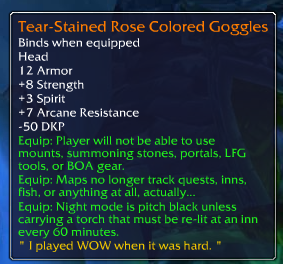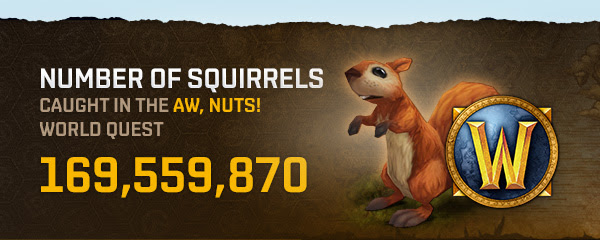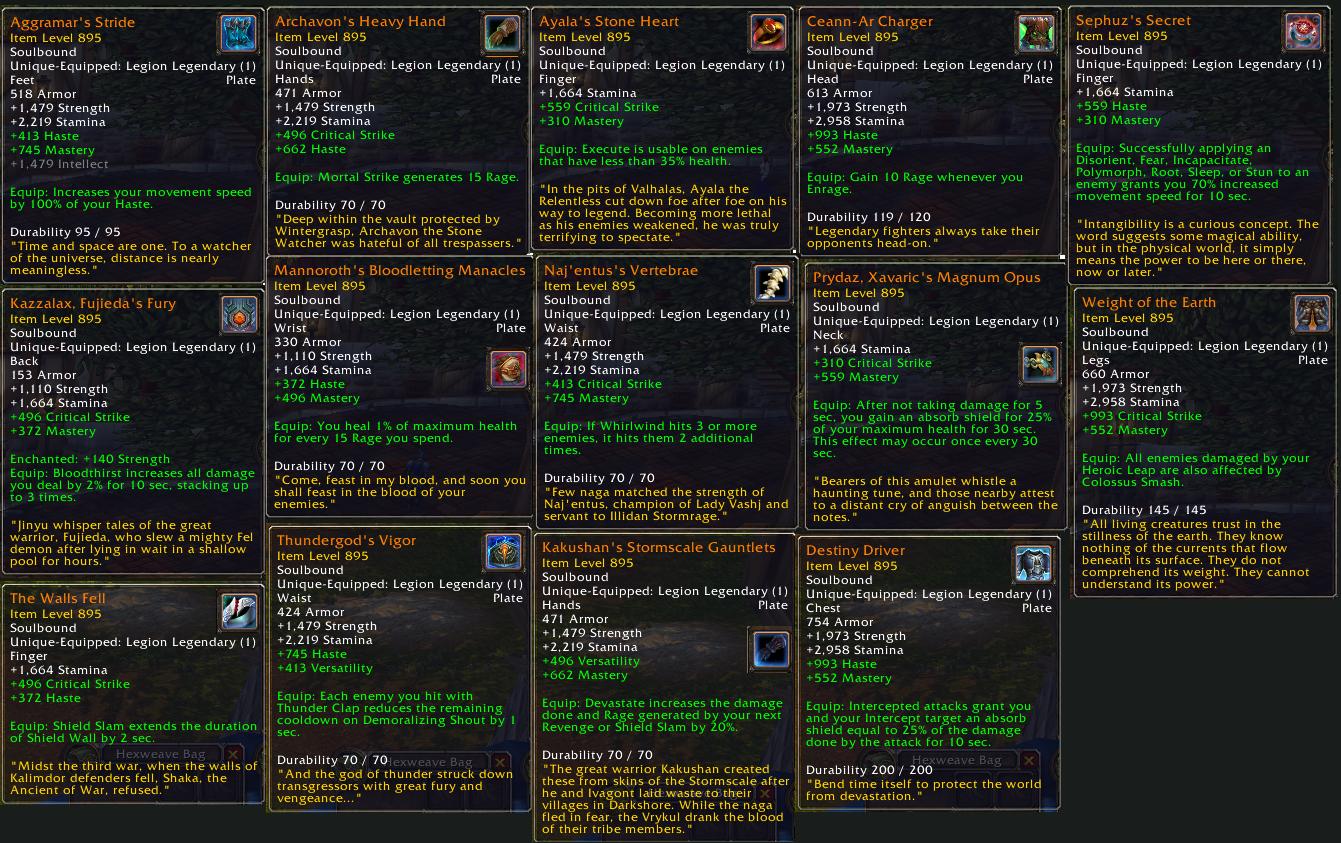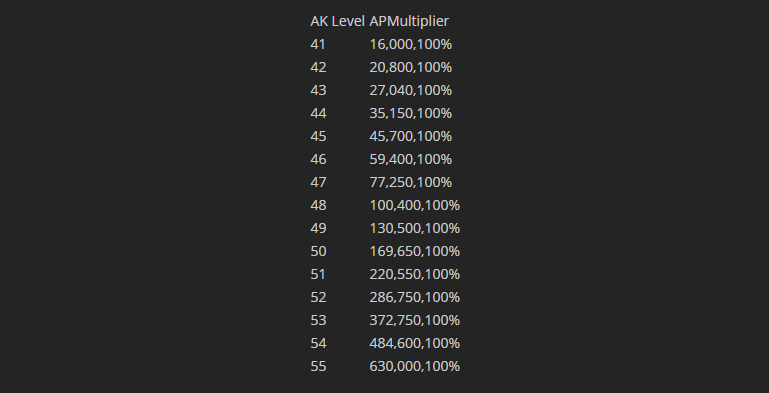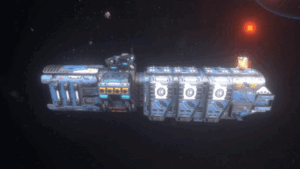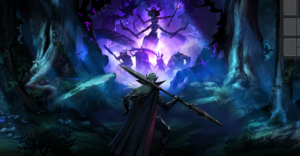Will the Next WoW Expansion Save Us from the Shackles of Legion? [Opinion]
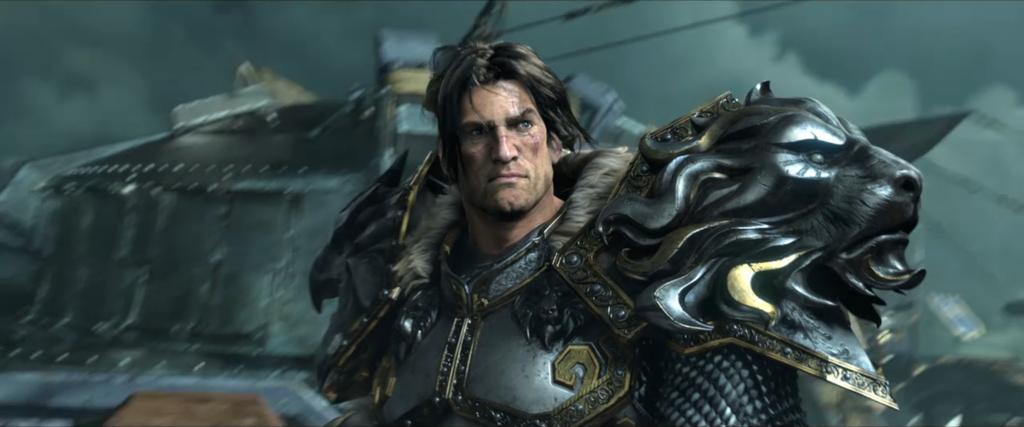
The new World of Warcraft expansion, Battle for Azeroth, was announced at this year’s BlizzCon. This has generated lots of hype in the community and, in my opinion, is a welcome departure from the systems in place with the current expansion, Legion.
For the uninitiated, World of Warcraft (WoW) is the MMORPG titan that changed the genre in 2004. It is the world’s most-subscribed MMORPG. To this day, it is still among the top grossing titles on PC worldwide. Chances are, you have either played or know someone who has played this game.
The most recent expansion, Legion, was released in 2016 and received positive praise after its launch. But how has the expansion held up one year later? Are players still happy with the game? Or have they removed their rose colored goggles and see something different?
Note: If you are looking for the tl;dr, click here to skip to the end.
Player “Factions” in Legion
If you look through the official WoW forums or reddit, you will see both praise and criticism for the game. It can be difficult to figure out who to believe. Because of its large player base, different groups of players have different expectations of what WoW should be.
The “vanilla veterans” often times reminisce about the good old days and how the game has evolved into something completely different. In general, they are disgruntled and either play on unofficial legacy servers or lock their xp gains at certain key levels to re-experience content in the live game. Blizzard’s recent announcement of WoW Classic servers has generated positive praise from this group of players.
Then you have the “golden age” gamers from the time period between Wrath of the Lich King and Cataclysm who consider the systems and stories during those expansions to be the best of their time. They often play Legion for as long as they can before burning out, or they stick around and offer compelling comparisons between the expansions that are usually discussed on YouTube, reddit, and the WoW forums. This group of players can provide useful insight on how the current game could be improved based on their previous experience from past expansions.
And finally, you have players who love the game in its current iteration. These can be both casual and hardcore gamers, as well as new and seasoned WoW players. Their opinion of Legion is usually based on how they choose to play the game, which we will further investigate in this article.
With millions of subscribers, Blizzard must be doing something right. There are valid opinions on the merits and shortcomings of WoW Legion, so let’s take a critical look at both sides to see what makes this game both magical and disenchanting at the same time.
Updates, World Quests, and Leveling, Oh My!
Updates
The developers promised frequent content updates with Legion, which they have been able to deliver. Some very observant redditors have written about this in greater detail, revealing that each major patch has been 77 days apart. In general, the community is happy with this change.
Some players are disgruntled with the implementation of content updates, especially the use of time-gating to limit rapid consumption of content. When the Broken Shore quest line was originally introduced in patch 7.2, the entire quest line was staggered over 3 months! Casual players were fine with this, but hardcore players were not. Some players developed an apathetic attitude towards the campaign and waited until all of the content was released to “consume” it in one sitting. While there is no problem with choosing when to play through new content, there is danger when a system creates player apathy by its design.
World Quests
Legion introduced world quests, which are similar to the public quests pioneered by Ultima Online and Warhammer Online: Age of Reckoning. World quests replaced the Daily Quest system that are common in most modern MMORPGs. Players are encouraged to complete world quests by rewarding them with faction reputation and emissary caches, which have a chance at loot, artifact power, and even legendaries.
Critics have called world quests “reskinned daily quests.” Even though players can choose which quests to complete, the world quests are not perceived as “dynamic events.” Completing a world quest does not usually result in a permanent change in the environment. NPC’s that may have been fighting, or otherwise unavailable, during a world quest return to their post after completion. Even the invasions that were recently introduced to the Broken Isles, which players were hoping would be epic conflicts with the legion, are simply world quests that spawn on a global timer.
Leveling
Since WoW has been out since 2004, it has the luxury of having over 10 years of content for players to enjoy. The lore of Warcraft is rich, and enthusiasts of the franchise always enjoy seeing their beloved characters come to life in this universe.
One of the biggest barriers for new players is leveling from 1-100. The “meta” for leveling right now is to equip heirlooms and spam dungeons until you get to level 100. At that point, you can level through any the Legion faction campaigns since the player’s current level determines enemy difficulty in Legion’s Broken Shores.
The inherent issue with leveling is that players have all of this content that is essentially ignored in order to reach max level. This can all be skipped with a Level 100 character boost, which comes at a price tag of $60. This is not only cost prohibitive for some players, but it additionally does not promote players from enjoying the content from previous expansions. If players do choose to level through quests, they often outlevel a quest hub and have to skip zones to reach level-appropriate areas in the Old World. Players who actually level this way often feel as though the world is lonely, since level 110 players are all concentrated in Legion areas with no good reasons to visit the old world.
One potential solution for this would be for the developers to streamline leveling through quests. Perhaps they can implement a system similar to Star Wars: The Old Republic’s Class Story system, which provides increased experience for campaign quests that are important for the character’s story and development. Another approach could be to use Legion’s current leveling system and allow zones in the old world to “adapt” to the player’s current level and adjust mob difficulty accordingly. The latter was recently announced as an upcoming game feature during BlizzCon 2017, which should greatly improve the leveling experience for new players or alts.
RNGesus Take the Wheel…
Legion introduced gearing and character progression systems that have been received with mixed reviews by the player base. Of them, the most discussed are titanforging, legendary equipment, and the artifact weapon.
Titanforged Items
Before Legion, endgame itemization was always defined by rigid item level caps. Dungeon gear was always inferior to Raid Finder (LFR) gear, which was always inferior to Normal, Heroic, and Mythic raid gear. In the past, a player who wore a full set of mythic raid gear would never get an upgrade from running dungeons.
Legion changed this by introducing titanforging. When you earn items from endgame activities (dungeons, raiding, world quests, etc), they have a random chance of upgrading their item level quality. By definition, an item is titanforged when it successfully upgrades by +15 or more item levels.
Those who support this system argue that it incentivizes mythic raiders to participate in other aspects of the game (such as dungeons and world quests) since there is the chance at an upgrade. This now gives those skilled players a reason to play with the casuals, right?
But what if a casual player in a heroic dungeon receives a titanforged piece of gear that is equal to, or even better, than the gear a mythic raider is wearing? Does that marginalize the weeks and weeks of wipes and progression efforts of that mythic raider? Is this fair?
This system definitely gives casual players a chance to access powerful gear in content that they can play. There is a low barrier to entry for dungeons and LFR, and the chance of titanforged equipment keeps players interested and excited for that next piece of shiny loot! But does this convenience come at a cost to the upper echelon of players?
Critics have stated that this system of chance takes control out of the players’ hands. Time invested does not necessarily mean an increase in power. All players now have access to powerful pieces of equipment from world quests, dungeons, and LFR that can be equal in power to mythic raid equipment. At the very least, critics of the system question why players would choose to conquer the toughest content in the game if there is a chance for comparable loot in easier content.
Legendary Equipment
Legendaries are the most difficult items to acquire in the game. They are more powerful than epic equipment, and historically required significant effort in the form of crafting, quests, dungeons, and raids.
Legion changed this system by making legendaries almost exclusively available randomly through drops. Sources of randomly dropped legendaries include (but is not limited to): dungeon bosses, raid bosses, world bosses, emissary caches from world quests, and mythic+ weekly caches.
The topic of randomly dropped legendaries is polarizing in the WoW community. At the simplest level, all players have access to the most powerful gear in the game, regardless of the difficulty in content they are able to clear. This equalized the playing field between casuals and mythic raiders, since a random legendary could drop from both a dungeon boss and a raid boss. Blizzard’s “bad luck protection” system ensured that your chance to receive a legendary increased over time if you completed “legendary-eligible content.” In other words, a casual player who only ran heroic dungeons every week and completed world quests theoretically had the same chance at a legendary as a mythic raider who only raided and killed raid bosses each week.
To make matters worse, each spec has 8-9 legendaries available to them (including legendaries which work for all specs in a class) plus 4 shared legendaries, for a total of 12-13 legendaries that could potentially drop per spec (and 1 crafted legendary per spec). For someone who played “regularly,” the first two legendaries dropped relatively quickly for a newly leveled 110 character. However, the drop rate after the first two legendaries decreased dramatically and was dependent on your bad luck protection and RNG.
Not all legendaries are created equally, either. For a given class and spec, legendaries are mixed between increasing player power and throughput or increasing utility and survivability. For some classes, there were clear best-in-slot (BiS) legendaries that made the spec. If you were not lucky enough to get your BiS legendaries, it could take several weeks, even months, to get the right legendaries and compete with others. This lack of control in a competitive raiding environment driven by min-maxing stats and equipment contributed to player frustration.
As a personal example, I play a holy priest. It is universally accepted in the healing community that the BiS legendary for holy priests during raid progression is this cape. I did not get this cape until the Nighthold raid was released (3 raid tiers into the expansion, 5 months after the release of Legion). Crazy, right? I thought so too. Thanks RNGesus.
Additionally, there is no real catch-up mechanic for legendaries. Players who come to Legion late (whether as a new player or returning to the game) don’t have any extra bad luck protection than someone who has been playing Legion since the launch. Thus, after they reach level 110 and get their first couple of legendaries, they are essentially MONTHS behind others who have been grinding bad luck protection since the launch. If they don’t get competitive legendaries early, their performance will suffer until they are blessed by the RNG gods with the right ones. Take a look at Warcraft Logs for any DPS spec and you will easily see which legendaries matter when you filter by spec.
Again, critics have stated that this system of chance takes control out of the players’ hands. Time invested does not necessarily mean an increase in power. If you do not get favorable legendaries early, you are left playing the waiting game (as long as you are completing legendary-eligible content) until you get the right ones to drop. Sure, you will eventually get them all if you continue to play the game, but your performance may suffer regardless of your skill as a player. Yes, some legendaries matter that much – some legendaries define their spec. And this system further contributes to player apathy. At the time of writing this article, I still do not have all of the legendaries for all three of my priest’s specs!
Artifact Weapon
Players who have been with Legion from the very beginning know that the artifact weapon system has evolved over time. Each spec gets a unique weapon as part of their class storyline, and these are intended to be the main weapons for each spec for this expansion.
Players level their weapons by consuming artifact power resources. Consider artifact power (AP) as the weapon’s experience. As a weapon’s artifact power increases, weapon traits are unlocked to make the weapon more powerful. There is an AP progress bar (like the player experience bar) to show you how far away you are from leveling up your artifact weapon.
Artifact knowledge is a system that accelerates artifact power gains over time. At the beginning of the expansion, players were required to research their artifact knowledge (AK) by using their order hall resources. With patch 7.3, this changed to global artifact knowledge with no cost to the player. In other words, all characters in the game now have the same artifact knowledge. Each level of artifact knowledge increases the artifact power you get. For example, you get 25% increased AP from AK level 1, compared to over 4,000,000% increased AP at AK level 40 (with a cap at AK level 55 at the time of writing this article).
Each weapon has 3 relic slots that boosts certain traits in the weapon. Patch 7.3 introduced a new system called the Netherlight Crucible. This system allows players to add randomly generated bonuses to their equipped relics based on a 3-tier system. As you level your Artifact Weapon, the three tiers of abilities will be unlocked for your 3 relic slots sequentially. Each relic you acquire, once socketed to your weapon, will generate a random Light and Shadow ability for Tier 2, and will additionally randomly generate 3 choices for a second Artifact Trait to boost for Tier 3. Players then pick their path based on which traits they prefer. To fully unlock all crucible traits, a player must level their artifact weapon to level 75.
The artifact weapon system provides players with a form of character progression after reaching the max character level (110). Now, players can continue to gain power by leveling up their weapon and feel like their efforts after reaching level 110 are meaningful.
So what’s the problem? AK increases globally for all characters every week until it is maxed. Critics have argued that this promotes player apathy, since actions taken today can be perceived as less rewarding than actions taken at max AK. To illustrate this point further, let’s look at the AK chart from 7.3:
If a player completed a world quest at the beginning of patch 7.3, they would receive 16,000,100% of the base AP rewarded from that world quest. Now if they completed the EXACT same world quest 15 weeks later at AK level 55, they would receive 630,000,100% of the base AP rewarded! Why should someone invest hours upon hours completing world quests and dungeons right now if they know that the value of their time is worth much more later?
Leveling up the artifact weapon is also extremely grindy. Coming from someone who plays a few hours each night (and upwards of 12 hours per day on weekends), I still have not unlocked all of the traits for my weapon through the Netherlight Crucible. From Blizzard’s perspective, this could be a good thing since it might keep players playing longer, but I have already lost guildees due to the grind. Burnout and apathy continue to be something that is discussed in my guild’s Discord channel. Granted, we are not a hardcore guild by any stretch of the imagination, but you have to wonder how motivated casual players will be to grind out the insane amounts of AP to level their weapon.
MMORPG veterans know that there is always some degree of “grind” when playing these types of games, whether it is in the form of character leveling or for power progression at end-game. While this is true and valid, the current artifact weapon system in Legion also prohibits the development of alternate (alt) characters or raiders who need to maintain swing specs for progression. Are you tired of playing that DPS hunter and want to tank a little on the side with your warrior alt? Great! But if your warrior’s artifact weapon isn’t leveled appropriately, you lose access to all of the powerful traits and bonuses from the Netherlight Crucible. Or are you an elemental shaman and your guild is short a healer for raid tonight? If you haven’t been maintaining your restoration weapon and keeping it leveled, good luck swinging to heals for progression.
Granted, both situations are possible with skilled players and/or additional time investment into those weapons. But it is a significant time investment, and I don’t want to minimize that. Personally, I am currently level 74 in my holy priest weapon, but when I am asked to swing spec into DPS, my shadow weapon is only level 51. And in a competitive raid environment, my performance suffers partly due to this disparity.
My last criticism for the artifact weapon is the Netherlight Crucible itself. While it does provide players with an increased level of customization for their relic slots, this is all done randomly. Players have no control over which traits are assigned to the relics they receive. Once they plug the relic into their weapon, the system randomly generates the traits they can choose from. For every weapon and spec, there are clearly superior traits that are sought after by competitive players. This new system not only makes it more difficult to assess the true power of new relics, but it also frustrates players that enjoy min-max theorycrafting to ensure optimal throughput during raid encounters. Every class Discord channel has all sorts of fancy calculators and guides to help people figure out which relics to equip because the system can be very confusing.
Mythic+ Dungeons
Legion introduced a new dungeon system that offered players with an endless scaling challenge for small groups (5 players). For those of you who played Diablo III, the mythic+ (M+) dungeons in WoW are similar to greater rifts. M+ dungeons have levels that scale in difficulty, offering increased rewards as you complete higher levels.
At certain levels, dungeons gain an “affix” that changes gameplay in some way. For example, the “explosive” affix appears in M+7 dungeons, and enemies periodically summon explosive orbs that detonate and deal party damage if not destroyed.
As a reward for completing a M+ dungeon each week, players receive a guaranteed piece of loot based upon their M+ performance in the previous week. The item level of this loot scales (up to a cap), so players are encouraged to complete higher level M+ dungeons to receive better loot.
Admittedly, mythic+ dungeons are a great addition to WoW. This system provides challenging content for small groups of players. It is easy to log in and complete a M+ dungeon, and it doesn’t carry the commitment of heroic/mythic raiding for those who are time-constrained. Additionally, the variety of affixes requires players to adapt their play style, modify their specs, and swap gear to increase chances for success. For example, my group all had to equip Prydaz one week to successfully complete a M+15 due to the sheer amount of damage taken and the “tyrannical” affix, which empowered all of the bosses in that dungeon.
Blizzard also introduced the WoW mythic dungeon invitational (MDI), where teams competed against one another in M+ dungeons for a chance at a prize pool of money. The MDI was a huge success and saw large numbers of viewership from the community as it was broadcast.
All of this sounds amazing, right?! Absolutely. Mythic+ dungeons are not inherently a problem, but the bugs within them are.
Bugs & Glitches
No, we’re not talking about insects here. We are talking about errors, flaws, and failures in programming or design that produce unexpected results. It is understandable for video games to have bugs, especially when new patches are released. However, it isn’t acceptable for these known issues to persist patch after patch, especially when you have mythic raiders competing for world first kills or when you have teams racing one another in the MDI.
For a competitive event like the MDI, you want your dungeons to be as bug-free as possible – especially when you are talking about a $100,000 prize and viewership that reached 26 million people overall! Unfortunately, there were dungeon bugs seen throughout the invitational which even led to drama in the finals. You can read more details about that here if you are interested.
Again, bugs are to be expected when new patches are released, but these dungeon bugs should have been addressed before the MDI. If I was one of the final two teams competing, I would have been extremely frustrated.
The Verdict (or tl;dr for the impatient)
There is no question that World of Warcraft is the premiere MMORPG on the market. Even after 13 years, it maintains relevance in the competitive MMO market and continues to be the gold standard for comparison in its genre. If you are looking for a stable game with a worldwide playerbase, you have a safe bet with WoW. Some of the great features include:
- Different levels of raiding difficulty to match player’s interest or skill
- Mythic+ dungeons provide scaling difficulty for small groups of players to tackle challenging content
- Lots of content for both casual and hardcore players, such as world quests, dungeons, and seasonal events
- Frequent content patches
- Over a decade of lore for players to enjoy
But no game is without its flaws. Legion was an improvement compared to its predecessor, Warlords of Draenor. However, there are a few key issues that need to be addressed:
- Player apathy and burnout due to grindy systems
- Time investment does not have a lasting impact on character progression. Previous raid tier of gear is obsolete by future patches
- New patches seem to always introduce bugs requiring several hotfixes. These should have been addressed before the mythic dungeon invitational
- There is no tangible “end” to character progression due to the artifact knowledge and artifact power system. Your character is never fully “completed” and progression lacks a sense of permanence
- Players have no control with the systems that are designed around RNG. Time invested does not always equate to power gained
- Heroic/mythic guilds have difficulty remaining relevant due to AK/AP grind. Several mythic guilds dropped out of the world first race after Nighthold before Tomb of Sargeras
- Some players have to do things they may not enjoy (WQ, easy dungeons, LFR) to keep their weapon updated, further promoting burnout
- Titanforging and the gear treadmill keeps players playing due to chance of an upgrade, but at what cost to player attitude and perception of the systems?
- PVP – I didn’t even touch on this, but there hasn’t been a new battleground since 2013. Enough said.
Why do I keep playing?
So you may be asking: why do I keep playing WoW? Even though I am critical of the current expansion’s flaws and shortcomings, I do enjoy this game overall. I started playing when The Burning Crusade was released in 2007, so I have a significant time investment into the game and my characters. There is a familiarity that comes with WoW every time I login, and it is the one MMORPG I have played over the years that I keep coming back to. If anything, I am critical because I want this game to continue to be successful.
One of the biggest reasons I started playing MMORPG’s is due to the social aspect. I play WoW with people who I have known for over 10 years, and there is a sense of loyalty and obligation both to them and to my guild to complete the current expansion’s raiding content.
Will I still be playing WoW in the future? My short-term answer depends on how Blizzard implements systems in Battle for Azeroth.
New Hope with the Battle for Azeroth Expansion
Players were given preliminary information about the next expansion at BlizzCon 2017. Thankfully, some of the issues I have with Legion were addressed, namely a revamping of the leveling system with scaling zones, the removal of randomly dropped legendary equipment, and the end of the artifact weapon system of character progression.
Every expansion brings both its own improvements and flaws. I am hopeful that Battle for Azeroth will learn from its shortcomings in Legion and continue to make World of Warcraft the MMORPG I am proud to call home.
Featured image courtesy of Blizzard Entertainment.

